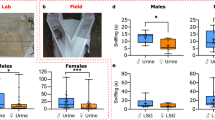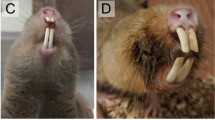Abstract
We examined the olfactory communication of the Neotropical short-tailed singing mouse, Scotinomys teguina, by investigating whether S. teguina responded to odors produced by the mid-ventral sebaceous gland of conspecifics. Females spent significantly more time investigating male odor than an odorless stimulus or a female odor. Males spent significantly more time investigating female odor than an odorless stimulus, but not that of a male odor. This latter result does not seem to be explained by differences in age or sexual experience of test subjects, but may be influenced by reproductive condition of the female odor donor. Male S. teguina spent significantly more time (1) investigating and (2) in total proximity to odors of estrous than non-estrous females. Males spent more time (1) investigating and (2) in total proximity to odors of males than non-estrous females. Finally, given the choice between odor of males vs proestrous females, males showed no preference. Thus, the mid-ventral gland in S. teguina seems to convey information about conspecifics, sex, and female reproductive condition. Male odor, compared with proestrous female odor, is equally interesting to males, suggesting that the gland also plays an important role in male–male communication. Sexual dimorphism in the size of the gland and in the amount of secretion produced by the gland may be related to either male–male competition or female choice.





Similar content being viewed by others
References
Bakker, J., Ophemert, J. V., and Slob, A. K. 1996. Sexual differentiation of odor and partner preference in the rat. Physiol. Behav. 60:489–494.
Blaustein, A. R. 1981. Sexual selection and mammalian olfaction. Am Nat 117:1006–1010.
Blondel, D. V. 2006. Social organization of a species of Singing Mouse, Scotinomys xerampelinus. MSc Thesis. University of Florida.
Brown, R. E. 1985. The rodents II: suborder Myomorpha, Social Odours in Mammals. pp. 345–457, in R. E. Brown, and D. W. MacDonald (eds.). Clarendon Press, Oxford, UK.
Brown, R. E., and Macdonald, D. W. 1985. Social Odours in Mammals. Clarendon Press, Oxford, UK.
Drickamer, L. C., and Brown, P. L. 1998. Age-related changes in odor preferences by house mice living in seminatural enclosures. J. Chem. Ecol 24:1745–1755.
Duvall, D., Müller-Schwarze, D., and Silverstein, R. M. 1986. Chemical Signals in Vertebrates. Plenum Press, New York, NY.
Englemann, M., Wotjak, C. T., and Landgraf, R. 1995. Social discrimination procedure: an alternative method to investigate juvenile recognition abilities in rats. Physiol. Behav 58:315–321.
Ferkin, M. H. 1999. Attractiveness of opposite-sex odor and responses to it vary with age and sex in meadow voles (Microtus pennsylvanicus). J. Chem. Ecol 25:757–769.
Ferkin, M. H., and Johnston, R. E. 1995. Meadow voles, Microtus pennsylvanicus, use multiple sources of scent for sex recognition. Anim. Behav 49:37–44.
Fernández-V. 2006. Olfactory responses of Neotropical singing mice (Scotinomys teguina) to the odors of the mid-ventral sebaceous gland. MSc. Thesis. University of Missouri-St. Louis.
Flood, P. 1985. Sources of significant smells: the skin and other organs, Social Odours in Mammals. pp. 19–36, in R. E. Brown, and D. W. MacDonald (eds.). Clarendon Press, Oxford, UK.
Gavish, L., Carter, C. S., and Getz, L. L. 1983. Male-female interactions in prairie voles. Anim. Behav 31:511–517.
Gottreich, A., Zuri, I., Barel, S., Hammer, I., and Terkel, J. 2000. Urinary levels in the male blind mole rat (Spalax ehrenbergi) affect female preference. Physiol. Behav 69:309–315.
Halpin, Z. T. 1980. Individual odors and individual recognition: Review and commentary. Biol. Behav 5:233–243.
Halpin, Z. T. 1986. Individual odors among mammals: Origins and functions. Adv. Study Behav 16:39–70.
Hooper, E. T., and Carleton, M. 1976. Reproduction, growth and development in two contiguously allopatric rodent species, genus Scotinomys. Misc. Public. Mus. Zool., Univ. Michigan 151:1–52.
Hurst, J. L. 1990a. Urine marking in populations of wild house mice (Mus domesticus Rutty). I. Communication between males. Anim. Behav. 40:209–222.
Hurst, J. L. 1990b. Urine marking in populations of wild house mice (Mus domesticus Rutty). II. Communication between females. Anim. Behav. 40:223–232.
Hurst, J. L. 1990c. Urine marking in populations of wild house mice (Mus domesticus Rutty). III. Communication between the sexes. Anim. Behav. 40:233–243.
Hurst, J. L., Hayden, L., Kingston, M., Luck, R., and Sorensen, K. 1994. Response of the aboriginal house mouse, Mus spretus Lataste, to tunnels odoured by conspecifics. Anim. Behav. 48:1219–1229.
InStat, GraphPad Software Inc. 1998. Version 3.0. San Diego, CA, USA. http://www.graphpad.com.
Jannett, F. J. Jr. 1981. Scent mediation of intraspecific, interspecific, and intergeneric agonistic behavior among sympatric species of voles (Microtinae). Behav. Ecol. Sociobiol 8:293–296.
JMP, SAS Institute Inc. 1989–1997. Version 3.2.1. Cary, NC, USA. http://www.jmp.com.
Johnston, R. E. 1983. Chemical signals and reproductive behavior, Pheromones and Reproduction in Mammals. pp. 3–33, in J. G. Vandenberg (ed.). Academic Press, New York, NY.
Johnston, R. E. 1985. Communication, The Hamster. Reproduction and Behavior. pp. 121–154, in H. I. Siegel (ed.). The Plenum Press, New York, NY.
Johnston, R. E. 2003. Chemical communication in rodents: From pheromones to individual recognition. J. Mammal. 84:1141–1162.
Johnston, R. E., and Jernigan, P. 1994. Golden hamsters recognize individuals, not just individual scents. Anim. Behav 48:129–136.
Kavaliers, M., and Colwell, D. D. 1995. Odors of parasitized males induced aversive responses in female mice. Anim. Behav 50:1161–1169.
Kavaliers, M., Choleris, E., Agmo, A., and Pfaff, D. W. 2004. Olfactory-mediated parasite recognition and avoidance: linking genes to behavior. Horm. Behav. 46:272–283.
Kleiman, D. G. 1977. Monogamy in mammals. Quart. Rev. Biol 52:36–69.
Kleiman, D. G. and Eisenberg, J. F. 1983. Part III Mechanisms of communication, pp. 147–149, in J. F. Eisenberg and D. G. Kleiman (eds.). Advances in the Study of Mammalian Behavior. Am. Soc. Mammal. Spec. Public. 7:1–751.
Koyama, S. 2004. Primer effects by conspecific odors in house mice: a new perspective in the study of primer effects on reproductive activities. Horm. Behav 46:303–310.
Künzl, C., Kaiser, S., Meier, E., and Sachser, N. 2003. Is a wild mammal kept and reared in captivity still a wild animal? Horm. Behav 43:187–196.
Mateo, J. M. 2003. Kin recognition ground squirrels and other rodents. J. Mammal. 84:1163–1181.
Mateo, J. M. 2006. The nature and representation of individual recognition cues in Belding’s ground squirrels. Anim. Behav. 71:141–154.
Müller-Schwarze, D. 1983. Scent glands in mammals and their functions, pp. 150–185, in J. F. Eisenberg and D. G. Kleiman (eds.). Advances in the Study of Mammalian Behavior. Am. Soc. Mammal. Spec. Public. 7:1–751.
Nelson, R. J. 2000. An Introduction to Behavioral Endocrinology. Sinauer Associates, Sunderland, MA.
Newman, K. S., and Halpin, Z. T. 1988. Individual odors and mate recognition in the prairie voles, Microtus ochrogaster. Anim. Behav 36:1779–1787.
Petrulis, A., Peng, M., and Johnston, R. E. 1999. Effects of vomeronasal organ removal on individual odor discrimination, sex-odor preference, and scent marking by female hamsters. Physiol. Behav 66:73–83.
Portillo, W., and Paredes, R. G. 2004. Sexual incentive motivation, olfactory preference and activation of the vomeronasal projection pathway by sexually relevant cues in non-copulating and naïve males. Horm. Behav 46:330–340.
Quay, W. B., and Tomich, P. Q. 1963. A specialized midventral sebaceous glandular area in Rattus exulans. J. Mammal 44:537–542.
Rothblat, L. A., and Kromer, L. F. 1991. Object recognition memory in the rat: the role of the hippocampus. Behav. Brain Res 42:25–32.
Sawrey, D. K., and Dewsbury, D. A. 1994. Conspecific odor preferences in montane voles (Microtus montanus): Effects of sexual experience. Physiol. Behav 56:339–344.
Solomon, N. G., and Rumbaugh, T. 1997. Odor preferences of weanling and mature male and female pine voles. J. Chem. Ecol 23:2133–2142.
Solomon, N. G., Ferkin, M. H., and O’boyle, R. 1999. Do pine voles (Microtus pinetorum) use numerous types of olfactory cues to discriminate gender? J. Chem. Ecol 25:2147–2159.
Stoddart, D. M. 1986. The comparative responses of mice and voles to conspecific and heterospecific odors in the field - A lesson in social behavior, Chemical Signals in Vertebrates. pp. 533–540, in D. Duvall, D. Müller-Schwarze, and R. M. Silverstein (eds.). Plenum Press, New York, NY.
Tang-Martinez, Z. 2001. The mechanisms of kin discrimination and the evolution of kin recognition in vertebrates: a critical re-evaluation. Behav. Process 53:21–40.
Tang-Martínez, Z., Mueller, L. L., and Taylor, G. T. 1993. Individual odors and mating success in the golden hamster, Mesocricetus auratus. Anim. Behav 45:1141–1151.
Taylor, G. T., egan, D., and Haller, J. 1983. Sexual experience, androgens and female choice of a mate in laboratory rats. J. Endocrinol 96:43–52.
White, P. J., Fisher, R. B., and Meunier, G. F. 1986. Female discrimination of male dominance by urine odor cues in hamsters. Physiol. Behav 37:273–277.
Xiao, K., Kondo, Y., and Sakuma, Y. 2004. Sex-specific effects of gonadal steroids on conspecific odor preference in rat. Horm. Behav 46:356–361.
Zala, S. M., Potts, W. K., and Penn, D. J. 2004. Scent-marking displays provide honest signals of health and infection. Behav. Ecol 15:338–344.
Zenuto, R. R., Fanjul, M. S., and Busch, C. 2004. Use of chemical communication by the subterranean rodent Ctenomys talarum (Tuco-tuco) during the breeding season. J. Chem. Ecol 30:2111–2126.
Acknowledgments
We thank Alex Ophir, Dimitri Blondel, Polly Campbell, and Molly Phillips (University of Florida, Gainesville); Jacqueline Miller (University of Toronto); George Taylor, Stan Braude, Beth Congdon, Danielle Lee, and Matt Ogburn (University of Missouri-St. Louis); and the anonymous reviewers for helpful comments. This research was supported by a Grant in Aid from the American Society of Mammalogists.
Author information
Authors and Affiliations
Corresponding author
Rights and permissions
About this article
Cite this article
Fernández-Vargas, M., Tang-Martínez, Z. & Phelps, S.M. Olfactory Responses of Neotropical Short-Tailed Singing Mice, Scotinomys teguina, to Odors of the Mid-Ventral Sebaceous Gland: Discrimination of Conspecifics, Gender, and Female Reproductive Condition. J Chem Ecol 34, 429–437 (2008). https://doi.org/10.1007/s10886-008-9428-0
Received:
Revised:
Accepted:
Published:
Issue Date:
DOI: https://doi.org/10.1007/s10886-008-9428-0




